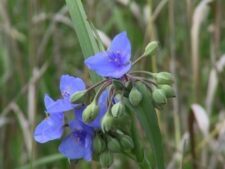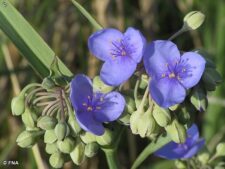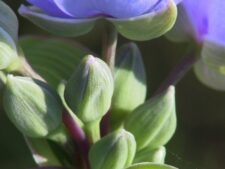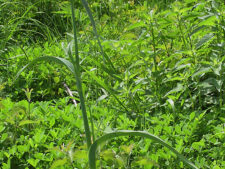
This native perennial has smooth, erect stems to 3 feet tall. The alternate, arching leaves are up to 15 inches long and quite narrow, becoming a bit wider at the base which wraps around the stem (E). At the top of the stem a cluster (cyme) of individually stalked flowers rises above 2 unequal bracts (A,E) similar to the leaves. The smooth, hairless sepals and flower stems (D) separate this species from closely related Bracted Spiderwort (Tradescantia bracteata) which also has 3 blue to rose-purple petals accented by 6 stamens with bright yellow anthers.
Found in moist or dry prairies, roadsides and open woods, flowering from May through July. It is uncommon in Neale Woods prairie restorations where it is more common than the closely related species of Spiderwort, Tradescantia bracteata. There are no records from Fontenelle Forest.
Hairless sepals and flower stems separate it from very similar Tradescantia bracteata.
Spiderwort flowers open in the morning, lasting only one day. Rather than dropping, they turn into a mucilaginous jelly that flows like a tear, a feature responsible for some of its rather picturesque common names like Job’s Tears, Widow’s Tears and Cow Slobbers. It is also known as Common Spiderwort and Blue Jackets.
The genus Tradescantia was named for John Tradescant, gardener to Charles I, a 17th Century English King. Tradescant’s son brought a species of spiderwort to England from America.
The content of NatureSearch is provided by dedicated volunteer Naturalists of Fontenelle Forest who strive to provide the most accurate information available. Contributors of the images retain their copyrights. The point of contact for this page is: Neal Ratzlaff.

 Identification
Identification


